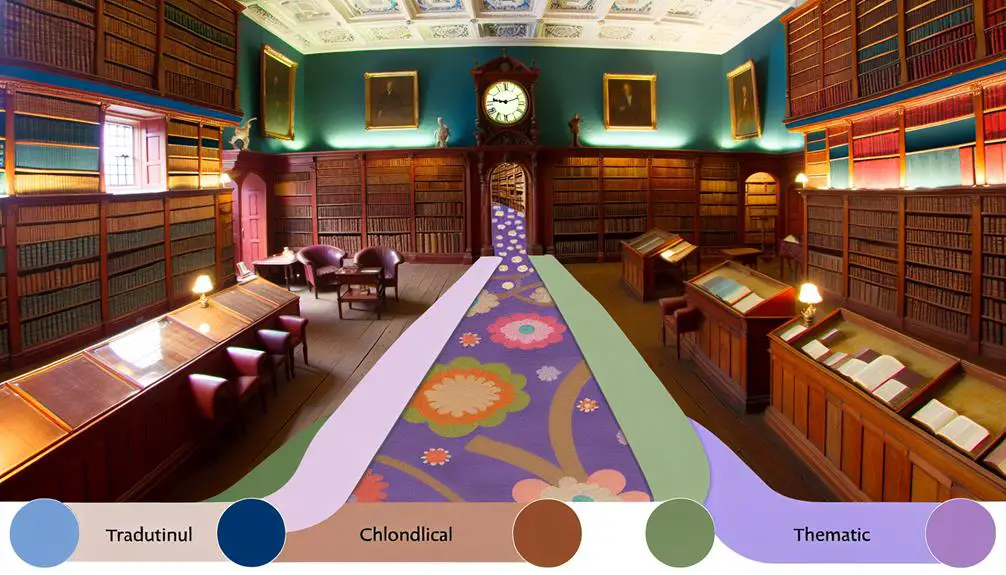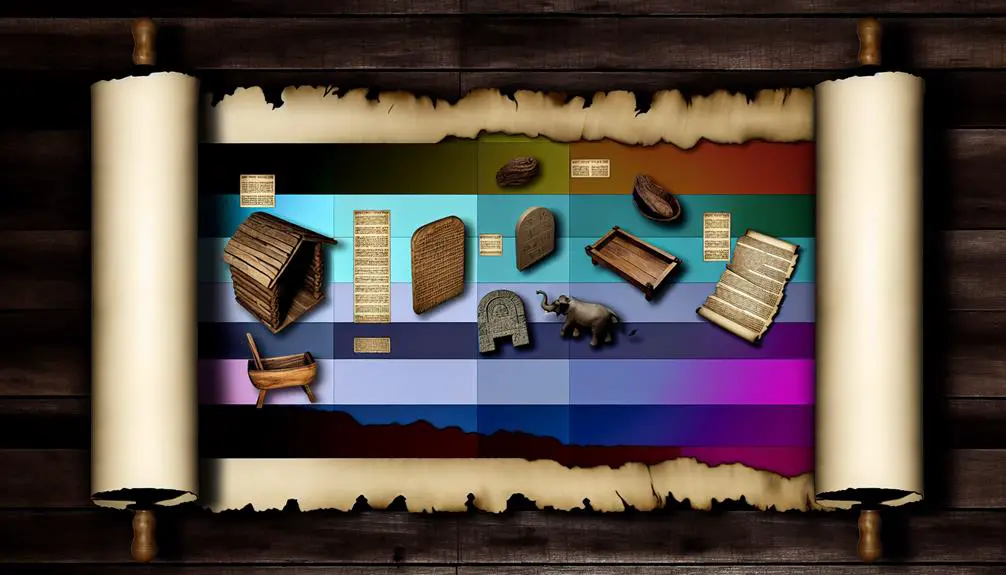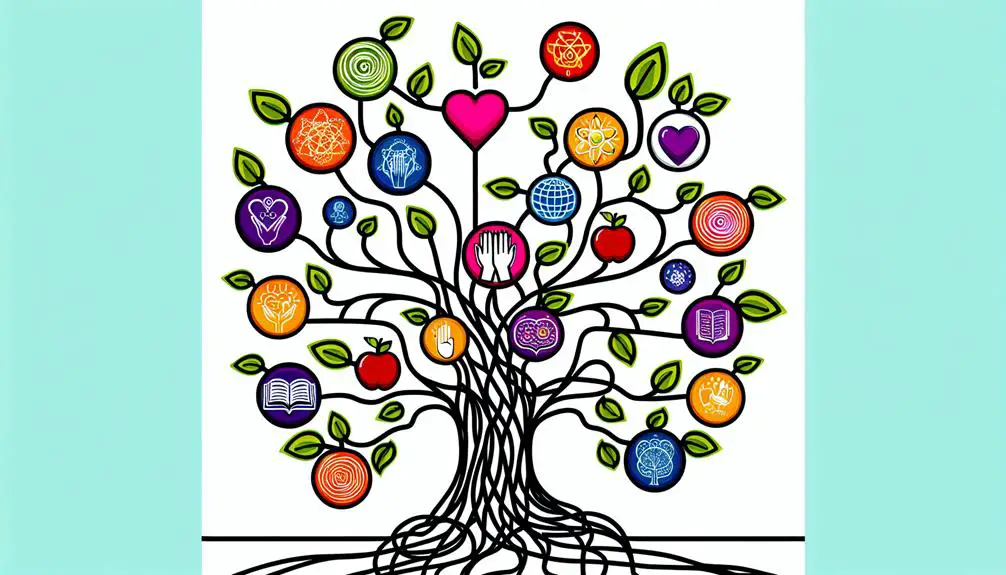Learn the best order to read the Bible in and unlock its mysteries, whether you're a beginner or looking to deepen your understanding.

Order to Read the Bible in
Just when you thought you knew everything there is to know about the Bible, you've stumbled upon a question that even seasoned scholars debate: in what order should you explore its pages? Whether you're a devout follower or a curious newcomer, the sequence in which you encounter the Scriptures can significantly shape your understanding and experience.
From the traditional Canonical order to a more thematic journey, each path offers its own insights and revelations. But before you decide on the route that's best for you, let's consider the merits and challenges of each approach. After all, you wouldn't start a journey without knowing all your options, would you?
Key Takeaways
- Begin with Genesis and Job to understand the origins of humanity and faith.
- Follow with Historical Books to trace God's divine plans and timelines.
- Conclude your reading with Prophets and the New Testament for a comprehensive view.
- Thematic reading paths, like exploring faith or redemption, can deepen understanding across Old and New Testaments.
Understanding Different Approaches

When approaching the study of the Bible, it's crucial to recognize that diverse methodologies offer unique insights and interpretations. Delving into the Bible's multiple layers requires an understanding of the cultural context and translation variations that influence how we perceive its teachings and narratives. Acknowledging the cultural context unlocks the historical and social backdrop of biblical times, providing a clearer picture of the events, customs, and practices described. It's not just about the words on the page; it's about comprehending the world from which those words emerged.
Similarly, translation variations play a significant role in how different audiences understand the Bible. Each translation can reflect the biases, interpretations, and linguistic choices of its translators, which means you're engaging with a text that's been filtered through numerous lenses. By comparing these variations, you gain insight into the nuances and complexities of biblical language, enhancing your ability to grasp the intended message.
Navigating these aspects requires a systematic approach, where you critically analyze and compare texts, taking into account the historical and cultural contexts as well as the intricacies of language. This methodical exploration enriches your study, offering a more nuanced and profound understanding of the Bible's teachings.
The Canonical Order
Exploring the canonical order of the Bible offers a structured pathway through its diverse and complex texts, guiding your understanding of its development and theological progression. This order isn't merely about sequence; it's a reflection of the religious communities' beliefs and priorities throughout history. It's crucial to note that translation variations and the inclusion or exclusion of Apocryphal books can significantly alter the canonical order, affecting your interpretation and emotional connection to the scriptures.
Consider the following to truly appreciate the depth and breadth of the canonical order:
- The Unity of Scripture: Despite the diversity of authors, genres, and historical contexts, the canonical order presents the Bible as a unified whole, weaving a coherent narrative of faith and human experience.
- Theological Development: This order allows you to trace the development of key theological themes, providing insight into the evolving understanding of God, humanity, and salvation.
- Cultural and Historical Context: Understanding the placement of books within the canon offers a glimpse into the historical and cultural circumstances that shaped their writing and compilation.
Historical Chronological Order

Transitioning from the Canonical order, you'll now explore the Bible through its Historical Chronological Order. This approach rearranges the text to align with historical events, offering a linear progression that enhances comprehension and retention.
You'll examine the benefits of this sequence and discover a recommended path for engaging with the scriptures in a methodical manner.
Chronological Order Explained
To understand the Bible's historical chronological order, it's essential to recognize that this approach arranges the events as they actually occurred in time, rather than following the traditional book sequence. This method offers a unique perspective, distinct from the variances introduced by translation methods or individual reading motivations.
- It aligns historical events, providing a cohesive understanding of biblical narratives.
- It offers clarity, especially in understanding the progression of God's relationship with humanity.
- It deepens emotional engagement, by allowing readers to experience the stories in the order they unfolded.
This analytical approach does more than just recount events; it reconstructs the biblical timeline, offering insights into the complexity and beauty of the scriptures.
Benefits of Historical Sequence
Having considered the impact of understanding the Bible in its historical chronological order, let's examine the specific benefits this method offers for a deeper comprehension of the scriptures.
Firstly, it illuminates the cultural context of each book, providing insights into the societal norms, laws, and traditions that shaped the narratives and messages. This understanding is crucial as it directly influences how we interpret various passages, addressing interpretive challenges by grounding our interpretation in the historical reality of the time.
Recommended Reading Path
Where should you begin if you're aiming to read the Bible in its historical chronological order? The quest to comprehend the Bible's intricate narrative in the sequence of actual historical events can be daunting. Yet, the systematic approach of reading it chronologically offers profound insights into its teachings and stories.
- Initiate with the Books of Genesis and Job, delving into the origins of humanity and early expressions of faith within their cultural contexts.
- Progress through the Historical Books, tracing the development of nations and the unfolding of divine plans, supported by digital platforms that elucidate timelines.
- Conclude with the Prophets and the New Testament, integrating prophecies and the life of Jesus Christ into the historical narrative, thus enhancing your understanding through a scholarly lens.
Thematic Reading Paths

Exploring thematic reading paths in the Bible allows you to uncover interconnected themes and narratives, enriching your understanding of its profound messages. Through theme exploration, you delve into the fabric of biblical teachings, unearthing the layers of meaning that transcend individual stories. This method offers a systematic approach, guiding you through the Bible's narrative diversity with precision and purpose.
In engaging with thematic reading paths, you're not merely reading; you're embarking on an analytical journey. This path requires you to identify and follow themes such as faith, redemption, or prophecy across various books and testaments. It's a scholarly endeavor that demands attention to detail and an appreciation for the complexity of biblical texts.
As you traverse these paths, you'll discover that themes often cross traditional boundaries between the Old and New Testaments, revealing a cohesive, overarching narrative. This approach doesn't only enhance your comprehension but also fosters a deeper connection with the material.
New Testament First
Starting with the New Testament offers a unique perspective on the Bible, allowing you to first engage with the teachings and life of Jesus before delving into the historical and prophetic foundations laid out in the Old Testament. This approach can profoundly shape your understanding and emotional connection to the biblical narrative.
By beginning your journey through the New Testament, you'll encounter:
- Gospel origins that lay the groundwork for Christian faith, presenting the life, death, and resurrection of Jesus Christ in a compelling narrative form that invites personal reflection and transformation.
- Epistolary insights that offer a direct window into the early Christian communities, their struggles, their faith, and their unwavering hope, connecting you to a two-thousand-year-old lineage of believers.
- A forward-moving revelation of God's plan for humanity, culminating in the person of Jesus, which then casts a retrospective light on the Old Testament, enriching your understanding of its texts and themes.
This method, while systematic, encourages a deep, analytical dive into the essence of Christian doctrine and its historical context, inviting you to a scholarly yet deeply personal exploration of your faith.
Old Testament Highlights

You'll find that the Old Testament's foundation is significantly shaped by the Genesis creation narrative, which introduces key themes of life, purpose, and divine interaction.
The Exodus story, focusing on freedom and covenant, not only offers historical insights but also establishes a theological framework critical to understanding later texts.
These narratives serve as pivotal points for analyzing the development of early monotheistic thought and the socio-political evolution of ancient Israel.
Genesis Creation Narrative
Delving into the Genesis creation narrative, we encounter a foundational text that meticulously outlines the origins of the universe, Earth, and humanity according to Judeo-Christian beliefs. This passage isn't just a historical recount but a rich tapestry of symbolic interpretations and teachings with profound modern relevance. The narrative invites readers to consider:
- The symbolic interpretations behind the creation days, offering insights into the nature of God and humanity's place in the universe.
- The modern relevance of these ancient texts, emphasizing stewardship of the Earth and the interconnectedness of all life.
- The deep emotional resonance found in the portrayal of a universe created with intention and care, reflecting a divine plan for harmony and balance.
Analyzing this narrative reveals layers of meaning that transcend its historical context, offering timeless wisdom and guidance.
Exodus and Freedom
Building on the foundational themes introduced in the Genesis creation narrative, the book of Exodus further explores the complex relationship between divinity and humanity through the lens of freedom and liberation. Central to this narrative is Moses' leadership, which acts as a conduit for the Israelites' journey from slavery to freedom.
This transformation is meticulously depicted against the backdrop of Pharaoh's heart, which symbolizes the ultimate resistance to divine will. The interplay between Moses' unwavering faith and Pharaoh's stubbornness serves as a profound exploration of human free will, divine intervention, and the quest for liberation.
Through a systematic analysis, you'll recognize that Exodus not only recounts a historical saga but also offers timeless insights into the essence of faith, leadership, and the struggle for freedom.
Incorporating Psalms and Proverbs
Integrating Psalms and Proverbs into your Bible reading regimen enriches the spiritual journey with profound wisdom and poetic solace. These books, central to Wisdom literature, serve distinct yet complementary roles. Psalms, with its roots in musical interpretation, offers a lyrical pathway to expressing the gamut of human emotions towards God. Proverbs, on the other hand, distills practical wisdom for daily living, guiding moral and ethical conduct.
Incorporating these texts can transform your reading experience:
- Emotional Resonance: Psalms allows you to find your feelings mirrored in its verses, from despair to joy, fostering a deep, emotional connection with the Divine.
- Intellectual Stimulation: Proverbs challenges you to think critically about virtue, wisdom, and discipline, offering timeless insights into leading a righteous life.
- Spiritual Growth: Together, they nurture a holistic faith that's emotionally rich and intellectually satisfying, deepening your relationship with God.
Approaching these texts systematically requires recognizing their unique contributions to biblical literature. Psalms' poetic expressions of faith and Proverbs' practical wisdom together enrich the tapestry of biblical understanding, offering a balanced diet of emotional nourishment and intellectual rigor.
Reading Plans and Tools

Having explored the enriching aspects of incorporating Psalms and Proverbs into your reading regimen, it's crucial now to examine the practical applications through various reading plans and tools. In this digital era, you're equipped with a plethora of resources to navigate the Bible's complexities. Digital resources offer unprecedented access to diverse translations and scholarly tools, enabling you to understand the nuances and translation differences that might otherwise elude you.
Plan Type |
Duration |
Focus |
|---|---|---|
Chronological |
1 Year |
Historical order of events |
Thematic |
6 Months |
Themes and topics |
Mixed |
1 Year |
Combination of OT and NT daily |
When selecting a reading plan, consider your goals and the depth of study you wish to achieve. Digital tools can assist in tracking your progress, providing insights into translation differences, and offering historical context that enriches your understanding. It's essential to choose a translation that resonates with you, as translation differences can significantly affect interpretation. Whether you prefer a literal translation for scholarly study or a more contemporary version for personal reflection, digital resources can guide you in making an informed choice, ensuring your reading plan is both enriching and accessible.
Frequently Asked Questions
How Does One's Personal Belief System or Religious Denomination Influence the Recommended Order for Reading the Bible?
Your personal beliefs or religious denomination deeply impact how you're advised to approach the Bible, intertwining cultural traditions with your reading motivation.
This guidance shapes your understanding and interpretation, systematically directing you through texts in a manner that resonates with your spiritual and cultural background.
Analyzing this influence reveals a tailored journey through the Bible, ensuring that your reading not only aligns with doctrinal views but also enhances personal growth and reflection.
Are There Any Psychological Benefits or Impacts Associated With Reading the Bible in a Specific Order?
Just as a journey through a labyrinth can transform your perspective, so can the sequence in which you read the Bible influence its psychological impact. Deliberate organization may enhance cognitive effects, fostering deeper comprehension and reflection.
Additionally, this tailored approach can bolster emotional resilience, equipping you to navigate life's challenges with spiritual insights. Analyzing texts systematically, rather than randomly, maximizes these benefits, enriching both your mental and emotional well-being.
How Does the Complexity of Ancient Languages Affect the Interpretation and Understanding of the Bible When Read in Its Original Versus Translated Forms?
When you delve into the Bible's original languages, you're grappling with linguistic evolution, which can significantly alter your understanding. Ancient texts carry nuances lost in translation, impacting interpretation.
Translation accuracy is paramount, yet even the best efforts can't capture every subtlety. By comparing translations, you can grasp the complexity and richness of the biblical text, but remember, each version reflects a translator's understanding, influenced by their linguistic and cultural background.
Can Reading the Bible Out of the Recommended Order Lead to Misinterpretations or Confusion About Its Teachings and Messages?
Reading the Bible without following a specific sequence can indeed cause confusion or misinterpretations. It's crucial to consider historical context and cultural differences when engaging with its texts. These elements shape the understanding of its teachings and messages.
Skipping around might make you miss the progression of themes and connections across the books. A systematic approach ensures you grasp the full spectrum of its insights, avoiding potential misunderstandings rooted in out-of-context readings.
How Do Modern Biblical Scholars Reconcile Contradictions Within the Bible When Proposing an Order for Reading?
Modern biblical scholars meticulously manage to reconcile contradictions through the meticulous methods of textual criticism and manuscript variability. They scrutinize scripts, seeking similarities and solving discrepancies, ensuring an enlightened understanding.
Conclusion
In conclusion, investigating the optimal approach to Bible reading reveals a multifaceted truth: no singular method suits all. Whether you're inclined towards a canonical sequence, a historical chronology, thematic exploration, or starting with the New Testament, the choice reflects personal spiritual quests and learning styles.
Incorporating Psalms and Proverbs enriches understanding, while modern reading plans and tools facilitate engagement. Systematically, each approach offers unique insights, underscoring the Bible's complex narrative and its profound impact on individual spiritual journeys.



Sign up